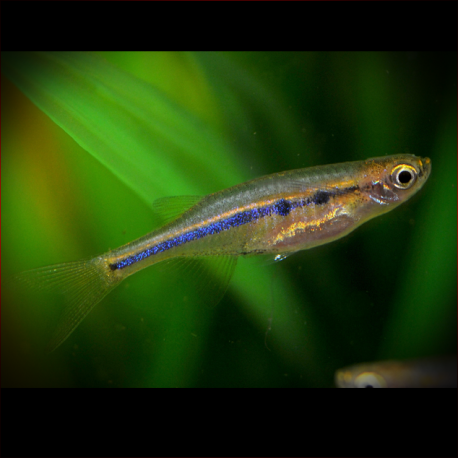More info
Datasheet
| Minimum Tank Size | 80 litres / 21.13 US gallons |
| Maximum Size | 3.0cm / 1.18inches |
| Temperature | 20°C / 68.00°F - 24°C / 75.20°F |
| Hardness | 2.02dgH / 36ppm - 10.03dgH / 179ppm |
| pH | 6.0-7.5 |
General Description
The Laubuka Dadiburjori, commonly known as Dadio, is a small fish species belonging to the Cyprinidae family. It is characterized by its small size, not exceeding 30 mm in standard length, and a dark bluish lateral stripe extending from the eye to the caudal peduncle, often forming circular spots along its length. The species is endemic to southern India, particularly found in states such as Goa, Karnataka, Kerala, and Tamil Nadu, in rivers like Meenachil, Bharatapuzha, Chalakkudy, and Sita.
Aquarium Setup
The Dadio should be kept in a planted aquarium with moderate water movement. The tank should ideally have a layer of vegetation covering part of the surface, with clumps of Taxiphyllum or similar plants to provide micro-organisms for both fry and adults to feed on. An air-powered sponge-type filter unit is recommended, matured before adding the fish. Water parameters should be maintained at a temperature of 20-24°C, pH of 6.0-7.5, and hardness of 36-179ppm (see table).
Behaviour
Known for its peaceful nature, the Dadio can coexist with various fish species in a community tank setup. As a schooling fish, it thrives when kept in groups of at least 8-10 individuals. Maintaining adequate numbers not only reduces their stress levels but also enhances the overall natural display in the aquarium.
Feeding and Diet
In their natural habitat, Dadios primarily feed on small invertebrates and zooplankton. In the aquarium, they accept dried foods of appropriate sizes but should also be offered small live or frozen fare like Daphnia, Artemia, and grindal worms. Providing a varied diet ensures their nutritional needs are met adequately.
Reproduction & Dimorphism
Dadios are egg-scattering spawners without parental care. Males typically choose plant leaves near the water surface for spawning. To enhance fry yield, a controlled spawning approach is recommended. Sexually mature females are slightly larger and deeper-bodied than males. Fertile eggs hatch in 2-3 days, with the fry becoming free-swimming in 4-5 days, requiring infusoria-grade food initially.
Habitat and Distribution
These fish inhabit small tributary streams and freshwater pools in southern India, often found near dense riparian or aquatic vegetation. The species is endemic to the region, with its type locality being Cochin, Kerala, India.

